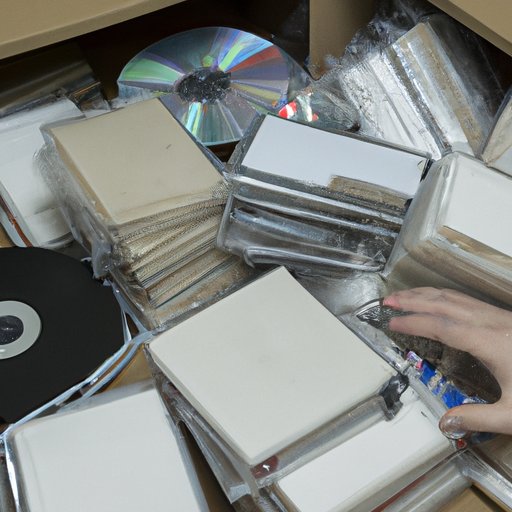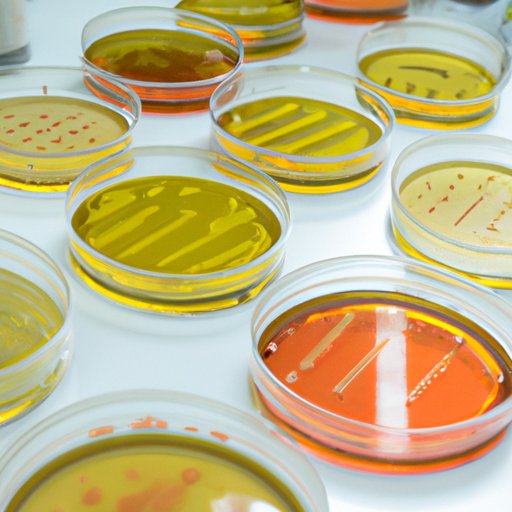Introduction
Culture media is an essential tool in the field of microbiology. It is a growth medium for microorganisms which provides nutrients and other conditions that allow microbes to thrive and be studied. Culture media can also be used to identify, isolate, and differentiate microorganisms from one another. In this article, we will explore what culture media is, its role in microbiological research, the different types of culture media used, how it is prepared and stored, and its impact on microbial growth and development.

Definition of Culture Media in Microbiology
Culture media is a nutrient-rich environment in which microbes or cells can grow and reproduce. It is made up of either liquid or solid components and includes various nutrients, such as proteins, carbohydrates, vitamins, minerals, and other growth factors. The composition of the culture media depends on the type of microorganism being studied and the desired outcome of the experiment.
Overview of Role of Culture Media in Microbiological Research
Culture media plays an important role in microbiological research. It is used to identify, isolate, and differentiate microorganisms from one another. It can also be used to study the metabolism and physiology of microorganisms, their ability to produce toxins or antibiotics, and their susceptibility to antimicrobial agents. Culture media can also be used to study the effects of environmental factors on the growth and development of microorganisms.
Types of Culture Media Used in Microbiology
There are several types of culture media used in microbiology. These include nutrient agar, selective media, and differential media.
Nutrient Agar
Nutrient agar is the most commonly used culture media in microbiology. It is a general purpose medium that supports the growth of a wide range of microorganisms. It consists of a mixture of proteins, carbohydrates, vitamins, minerals, and other nutrients.
Selective Media
Selective media is designed to favor the growth of certain microorganisms while inhibiting the growth of others. This type of media is often used to isolate specific microorganisms from a mixed population. Examples of selective media include MacConkey agar, which is used to detect the presence of gram-negative bacteria, and Mannitol Salt agar, which is used to detect the presence of Staphylococcus aureus.
Differential Media
Differential media is used to differentiate between different species or strains of microorganisms. This type of media contains indicators that change color when exposed to specific metabolic products produced by the microorganisms. Examples of differential media include Eosin Methylene Blue agar, which is used to differentiate between gram-positive and gram-negative bacteria, and Urea agar, which is used to differentiate between Escherichia coli and Proteus vulgaris.

Preparation and Storage of Culture Media
Culture media must be prepared and stored properly in order to ensure accurate results. Proper sterilization methods must be used to prevent contamination. Temperature requirements must also be met in order to maintain optimal growth conditions. Additionally, culture media must be handled and stored according to guidelines in order to extend its shelf life.
Sterilization Methods
Culture media must be sterilized prior to use in order to prevent contamination. Autoclaving is the most common method of sterilization. This process uses high pressure and steam to kill any microorganisms present in the media. Other methods of sterilization include filtration, dry heat, and chemical sterilization.
Temperature Requirements
The temperature of the culture media must be maintained at optimal levels in order to support microbial growth. Most microorganisms grow best at temperatures between 25°C and 37°C. However, some microorganisms require lower or higher temperatures in order to grow.
Handling and Storage Guidelines
Culture media must be handled and stored according to guidelines in order to extend its shelf life. Culture media should be stored in a cool, dark place and away from direct sunlight. Additionally, it should be kept in an airtight container and not exposed to extreme temperatures.

Impact of Culture Media on Microbial Growth and Development
The composition of the culture media has a significant impact on the growth and development of microorganisms. Nutrient availability, pH levels, and oxygen levels all play a role in determining the growth and development of microorganisms.
Nutrient Availability
The availability of nutrients in the culture media affects the growth of microorganisms. Different types of microorganisms require different types and amounts of nutrients in order to grow and reproduce. If the nutrients are absent or present in insufficient amounts, the microorganisms may not be able to grow.
pH Levels
The pH level of the culture media also affects the growth of microorganisms. Most microorganisms grow best at a neutral pH of 7.0. However, some microorganisms require acidic or alkaline conditions in order to grow.
Oxygen Levels
The oxygen levels of the culture media also affect the growth of microorganisms. Aerobic microorganisms require oxygen in order to grow, while anaerobic microorganisms do not. If the oxygen levels are too low, aerobic microorganisms may not be able to grow, while anaerobic microorganisms may be able to thrive.
Conclusion
In conclusion, culture media is an essential tool in the field of microbiology. It is used to identify, isolate, and differentiate microorganisms from one another. There are several types of culture media used in microbiology, including nutrient agar, selective media, and differential media. Culture media must be prepared and stored properly in order to ensure accurate results. Additionally, the composition of the culture media has a significant impact on the growth and development of microorganisms. Further research is needed to better understand the role of culture media in microbiological research.
(Note: Is this article not meeting your expectations? Do you have knowledge or insights to share? Unlock new opportunities and expand your reach by joining our authors team. Click Registration to join us and share your expertise with our readers.)
